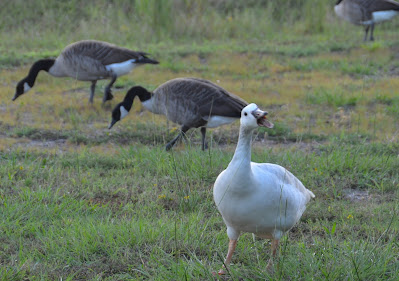Don't Hate Me Because I'm Beautiful
Birds of a feather do flock together, however this particular bird was oblivious to her obvious uniqueness. I discovered this beautiful goose recently and learned she’s not only rare but probably
new to the northern Myrtle Beach area as to date, unreported. And while the rest of her species appeared to be accepting her, her coloration was completely different.
 This Leucistic Canada is a Prime Example Why We Should Never Let Anything - Especially Our Appearance, Deter Us From Pursuing Our Dreams and What We Feel Destined to Be and Do in Life
This Leucistic Canada is a Prime Example Why We Should Never Let Anything - Especially Our Appearance, Deter Us From Pursuing Our Dreams and What We Feel Destined to Be and Do in LifeAfter some research I identified her as a
Leucistic Canada Goose, a species which is hated by some and adored by others. Currently, there's quite a controversy in Surfside Beach, SC over whether they are a nuisance or just more wildlife to live around and enjoy, basically. I dubbed her
Lucy Bob for her genetics and for her curious behavior – and since I don’t know positively if she’s male or female yet. Read on.
As you can see, except for the lack of a few genes that tell her Melanin to
provide which pigments where, she appears as normal as the rest of the Canada Geese. I ultimately realized that Lucy's actually a little more adventurous, confident, and perhaps a little smarter - in some ways I learned as I observed her over the week she was here.
I learned too that she’s not what's categorized as an Albino Canada because primarily, she
does have the normal black, vs pink eyes indicative of albinism. Notice that her beak is mottled, and her legs and feet are a pale orange not black, like the rest of her species. While her body has small patches of
light beige and grey, her head however is completely white in stark contrast to Canadas' typical dark black heads.
I reached out to nearby bird clubs and the news and no one
had noticed her so perhaps she’s new to the area because she's just migrating through. I for one however, would love to see her stay and share some Leucistic offspring with the many avid birders here.
She appeared to be normal, well fed, and had the same behaviors as the rest of the normally colored Canadas. Unlike other species, all the "normal" Canadas in this flock appeared to have accepted her and let her graze, feed, sleep, swim and even fly off to roost at dusk with them.
There's another species of Canada that's a bit lighter in coloration, so it was important that I get a shot of her with the rest of her flock for comparison and also that she be observed with her neck outstretched to garner its length and girth to correctly identify her. Or him. The only thing I noticed that might be awry with Lucy, was what I thought was a tic, as she stretched her neck, then bobbed through the field, whereas the rest of the flock was focused on keeping their heads staunchly on the ground, feeding as they normally do.
We're all too familiar with how nonplussed the Canadas are by traffic, but Lucy has gone above and beyond as far as venturing onto a 4 lane at rush hour. So much so, that the rest of the flock stayed back, while some went on high alert and even honked at her. Presumably a couple were alerting her to come back, out of danger.
Lucy wasn’t to be dissuaded however and I cringed as I
watched cars speed close to her as she kept pursuing that dream we all have for the greener grass on the other side. In Lucy's case that was across the road. Literally.
People in the area love and appreciate the wildlife as a general rule, so
thankfully some drivers stopped, gestured and shouted loudly to try to scare
her off the road and back to the grass.
But Lucy B wasn’t to be dissuaded, even though the rest of the flock didn’t
follow.
Finally, one Canada took matters into his own wings, as it
were, and took to the air instead, alerting the rest of his little flock to follow. Luckily, Lucy Bob eased into the formation as
well and lived to see another day.
I’ve posted some photos here as I don’t know if Lucy Bob’s a
permanent resident now or how long she’ll be here, so enjoy this beautiful and
rare sight and keep your eyes to the sky in hopes you spot this bird of a different feather or her offspring in your area.




.jpg)


Comments